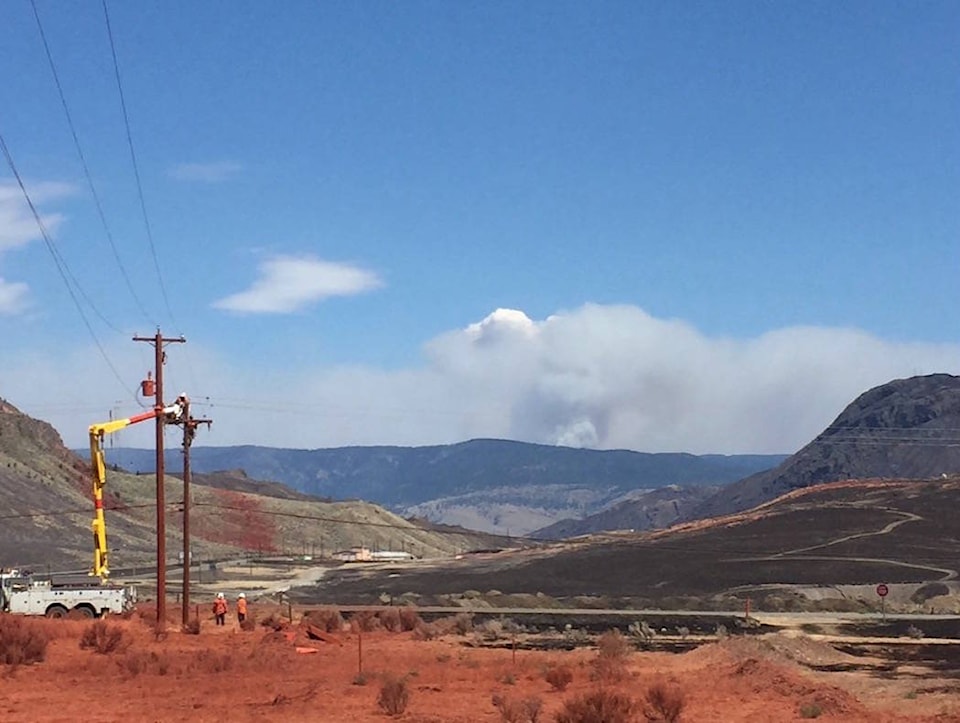When Greg Hiltz—a BC Hydro sub-foreman for Cache Creek for the last three years—surveyed the initial damage from the Elephant Hill wildfire on July 7, he thought the Village of Ashcroft would be without power for some time.
“When I saw all the transmission lines and distribution lines start to fall over, I was thinking it could be at least a week [before power was restored],” he says. In the end, BC Hydro crews got the power back on in under 36 hours; a testament to the hard work of dozens of people.
Hiltz says that in his three years of living and working here, such a lengthy power outage was unknown. “A couple of hours [without power] would have been the most.” He says that Ashcroft got lucky on the day of the fire.
Ashcroft’s power usually comes from the substation at the foot of Government Street, but the transmission lines took a beating in the fire. “We had to isolate that substation, which means we had to back-feed from Clinton.
“The fire burned through, and burned a section of the line we were able to quickly repair. We could back-feed Ashcroft through the Clinton substation. The way the system is set up, we can back-feed either way: from Ashcroft to Clinton or vice-versa.”
Hiltz says that the back-feed did not come from the large Kelly Lake station. “There’s a little tiny substation just on the Ashcroft side of Clinton, between Clinton and the rodeo grounds. We were able to back-feed from there all the way through to Ashcroft once we had the line repaired and rebuilt, there by Boston Flats.” The Ashcroft substation came back online on July 11.
Hiltz says that Ashcroft fire chief Josh White asked what the Ashcroft Volunteer Fire Department could do to help (Hiltz is also a member of the AVFD). “They were able to protect some of the structures out there along the bluffs [on Highway 97C] so we didn’t lose any more. A lot of those poles along the bluffs are hard to reach. It would have been more of a struggle. We’re lucky that we didn’t lose any more than we did along that stretch, that’s for sure.”
In the immediate aftermath of the fire, BC Hydro trucks and crew members were very visible around the area. Hiltz estimates that there were at least 10 crews, including contract crews, on the distribution side, with each crew comprised of a pickup truck, a bucket truck, and a digger truck, as well as between five and seven crew members. There were also four or five transmission crews, which included a helicopter, as well as heavy equipment for digging new roads to get to the sites where infrastructure needed to be replaced.
When The Journal notes that the road-building and equipment-replacing high on the hillside to the west of the river was watched with great interest, Hiltz laughs. ‘They put on a pretty good show, eh? When something like this happens, it’s pretty cool to see how everyone works together. You make some phone calls to senior management, they get crews here in a hurry.”
Although Hiltz initially thought the power would be off for a week, he says that once Hydro did its initial assessment of the situation on July 7, he was fairly confident they could get at least some of the power on by nightfall on July 8. “As long as we didn’t lose any more structures, we could do that. I didn’t really expect to get it all back on Saturday night, but we surpassed most of our expectations.”
During the day of July 8, Hiltz says some crew members went around town setting up isolation points, so that when they re-energized things they didn’t overload the system and make everybody go back out.
“We picked up small sections at a time and basically let some of the fridges and freezers and air conditioners come back on, then we’d go in and charge another section.”
Hiltz has nothing but praise for the ladies at the Ashcroft Legion who kept the Hydro crews, firefighters, and other volunteers fed. “Man oh man, they’re the ones who deserve the really big applause, for sure.”
Hiltz says there were times when he was wearing both his Hydro and firefighter hats. “With communication being the way it was, I was talking to Josh as often as I could, trying to help them out. There wasn’t much down time, but there were tidbits of information I could give Josh about which lines were de-energized, grounded, etc. to make sure it was safe for them.”
On the morning of July 8, crews also started working to clear Cornwall Road from the bridge right through the Ashcroft Reserve, so that the road could be opened for emergency personnel. Although the Reserve also draws its power from the Ashcroft substation, the power there was out for a week.
Hiltz says crew members started work between 7 and 8 a.m., and that for the first two-and-a-half weeks were working 16-hour days. At that point, with the bulk of the damage repaired, things were scaled back to 10- to 12-hour days. “People were starting to get tired, and the company didn’t want to burn everybody out. And they wanted to keep us safe. It’s not a game of second chances.”
Looking back on the experience, Hiltz says he hopes he never sees anything like it again. “It was quite an eye-opener. I have some experience of storms in Nova Scotia, been through some hurricanes. The damage is quite different, but the results are the same. This one here: like I say, it was a real eye-opener as to what can possibly happen and what can go wrong.”
